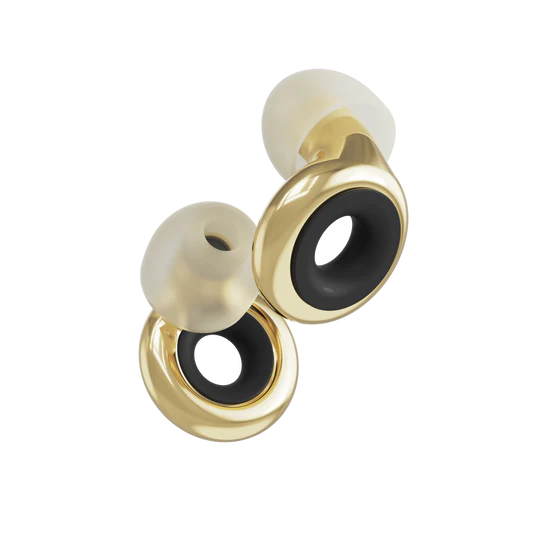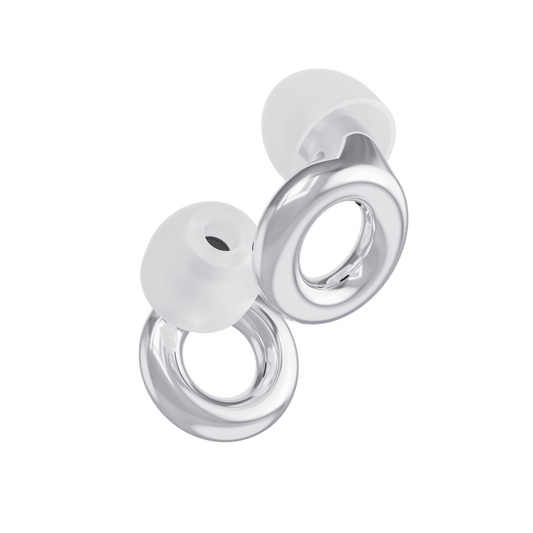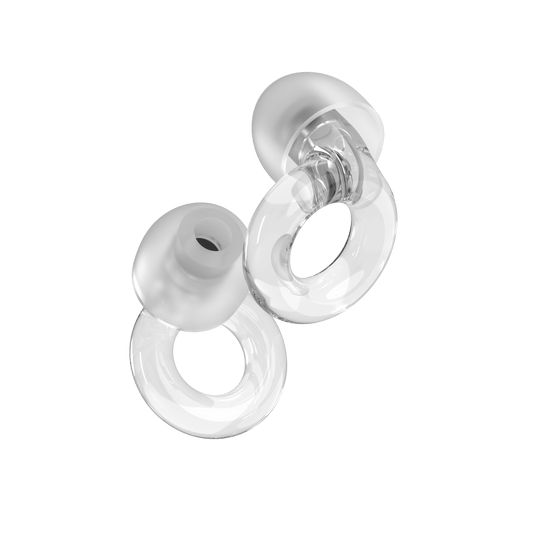Key takeaways
- Misophonia is a condition that can cause sensitivity and extreme reactions to certain sounds
- It can be debilitating for some people
- There’s no cure for misophonia but there are ways that you can reduce the impact it has on your life
- You could try therapies like CBT and counterconditioning
- You could also try developing coping strategies to help you better deal with irritating sounds, such as wearing earplugs, using white noise, and finding support groups
If you have misophonia, it can be debilitating. Luckily, there are some misophonia treatments out there that can help you to manage your symptoms and live a less stressful life.

What is misophonia?
First things first, what exactly is misophonia? It’s always good to have a clear understanding of what something is before we start tackling how to treat it.
Misophonia, then, is a condition that causes extreme sensitivity – and in some cases, an extreme reaction to – certain sounds.
If you find yourself bristling at the sound of someone chewing their food, feel angry when you hear fingers drumming on a table, or the noise of someone breathing leaves you seething, you could have misophonia.
Misophonia can have a big impact on one’s life. If you have a particular trigger sound, like the sound of people eating, then you may actively avoid putting yourself in situations where you might be exposed to this noise. That means you might avoid going out for meals with friends, or you may refuse to eat lunch with your colleagues. People with misophonia may end up feeling isolated, especially if their friends, family, employer and colleagues don’t understand the condition.
Misophonia treatments
We can all agree that, if you have this condition, it can be pretty hard to live with. So what are your options? Unfortunately, there’s no cure, but there are various treatments for misophonia, which may help you to live a symptom-free life – or, at least, reduce the intensity of your reactions to sounds. Take a look at the treatment options outlined below, in no particular order, if you’re wondering how to treat misophonia.
1. Tinnitus retraining therapy
Tinnitus retraining therapy, or TRT, is a treatment that was originally developed to help people with tinnitus. Tinnitus is a condition that causes someone to hear a buzzing or ringing sound in their ears which, much like misophonia, can be hard to live with, so TRT aims to help people tolerate the ringing sound.
It’s often also used as a misophonia treatment. Both misophonia and tinnitus originate in the brain, rather than being a problem with one’s hearing, and so both can benefit from similar treatments.
TRT combines sound therapy with counseling. It’s designed so that people with misophonia get used to their trigger sounds so that they no longer bother them as much. The sound therapy part of TRT aims to decrease the strength of the trigger sounds by using music or background noise to decrease their strength.
One analysis used TRT as a treatment for 184 people with misophonia. When asked “How much of a problem is your misophonia?”, 83% of the individuals (152 people) showed significant improvement after their course of TRT treatment.
2. Counterconditioning
This is a type of therapy that changes one’s emotional response to a trigger. It aims to replace a negative feeling, like anger or anxiety, with a positive or even neutral one.
As a misophonia treatment, then, counterconditioning therapy gets the person with misophonia to listen to a triggering sound and learn to reduce their reaction to it through something that elicits positive emotions. For example, the noise of someone chewing might be paired with a photo of a loved one, with the intention that – over time – the negative feelings associated with that sound will subside, and be replaced by positive ones.
One investigation used counterconditioning therapy as a treatment for a middle-aged woman who was disabled by severe misophonia. After a 13-week course of treatment, the patient reported 82.1% recovery, and 93.1% recovery at a follow-up one year after the end of treatment.
3. Cognitive behavioral therapy
Cognitive behavioral therapy, or CBT, is a talking therapy which can help you to manage your emotions, feelings, and responses to certain situations by changing the way you think.
It’s based around the premise that your thoughts, feelings, physical sensations and actions are all connected. That means that if you have negative thoughts and feelings, you can be trapped in a negative cycle that’s hard to get out of. CBT helps you to change these negative thought patterns to change your response to triggering sounds, and helps you regulate the emotional responses you feel.
It does this by:
- Helping individuals to understand the thoughts and behaviors that are associated with their sound triggers
- Examining these thoughts and behaviors to understand whether they are helpful or unhelpful
- Changing those thought patterns from unhelpful to helpful, and modifying behaviors associated with triggering sounds
Let’s say you’re someone who is triggered by the sound of a colleague clicking their pen during a meeting. You might think “They’re doing this on purpose to annoy me! They don’t care about me at all! Now I’m going to have to get up and leave the room, and I’m going to look like I don’t care about this meeting!”. You might actually get up and leave the room, missing part of the meeting.
CBT would retrain you to think in a different way. Perhaps you might instead think something like “They’re not doing it on purpose. They probably don’t even realize that they’re doing it. I’ll have to focus on what the speaker is saying so I don’t miss any important information.” Instead of leaving the room, you might lean forward and listen to what’s being said more intently. Rather than the feelings of anger that are associated with the first set of thoughts, you should instead feel calmer and more in control of the situation.
One research study found that after eight sessions of CBT, 48% of participants experienced an improvement in their misophonia. As a misophonia therapy, then, CBT can be quite effective. You should speak to your healthcare provider in the first instance about accessing therapy, or you can go directly to a private clinic.
4. Dialectical behavior therapy
Dialectical behavior therapy (DBT) is another type of therapy that helps patients to manage their emotions through a variety of techniques including mindfulness, distress tolerance, emotional regulation and interpersonal effectiveness.
It’s based on the techniques used in CBT, but is specifically designed for people who feel very intense emotions. DBT aims to help people understand their feelings, learn skills that can help to manage those feelings, and make positive changes in one’s life. The main difference between CBT and DBT is that as well as changing your thought patterns, DBT has a focus on accepting who you are.
More research is needed into how DBT can be used as a misophonia treatment, but there is some evidence that it may reduce the severity of emotions felt upon hearing a triggering sound, particularly for those individuals who do not respond well to CBT.

How to deal with misophonia
Another option is for you to devise coping strategies and mechanisms that will help you to better deal with misophonia. This is less about treatment of misophonia, and more about understanding the condition, learning your own triggers, and figuring out ways to help you have a less intense reaction to triggering noises.
1. White noise
Some people find that white noise helps to mask the sound of their trigger noises which, in turn, means they have less of an emotional reaction – or they may even have no reaction at all.
You can get devices like white noise machines that fill a room with white noise. These can be effective when you don’t necessarily want to wear headphones or earphones, like if your trigger noise is snoring and you don’t like wearing headphones at night.
You can also get apps for your phone which play white noise on demand, so you can simply pop in your headphones and press play when you’re in situations in which you might encounter your trigger noises.
2. Earplugs
Noise-reducing earplugs are another way you can mask the sounds that trigger your misophonia, helping you to stay cool, calm and collected in any situation.
Try a pair or earplugs like the Loop Experience Plus (Pro), which filter sounds to a reduced volume while still allowing you to hear clearly thanks to a patented acoustic channel and mesh.
You can choose from different Loop Earplugs for different environments, depending on what’s happening around you and how much background noise there is. You can also get even more control over the volume around you with Loop Mutes, which you can add to your Experience earplugs for an extra 5 decibels of sound protection.
That means you can wear them in meetings or in the break room to take the edge off those annoying noises while allowing you to stay focused on what’s being said – so you’ll never have to leave the room and miss something important again.
It’s not recommend to wear earplugs constantly, as that could make your reaction to the triggering sounds worse in the long run. If you completely avoid your trigger sounds, then you can become even more susceptible to them. Instead, it’s best to use earplugs as a tool to take the edge off as you get more used to the triggering sounds.
Our earplugs for Misophonia
3. Noise-canceling headphones
In situations where you don’t need to stay alert but when triggering noises may be unavoidable, for example, when you’re sandwiched between two strangers on a plane, noise-canceling headphones can be a great solution.
They’ll block out all the sounds so you can stay calm and focused on whatever you’re doing – whether that’s trying to work, reading your book, or simply sitting and enjoying the peace and quiet.
Noise-canceling headphones give you some peace and quiet as all noise is blocked out. That means you don’t learn to live with the triggering sounds, as you can’t hear them! That’s different to earplugs, where the sound isn’t completely gone, helping you to learn how to deal with the noise.
4. Meditation
Aaaaand… breathe. Meditation can help you to relax, as it activates the parasympathetic nervous system (the part of our brain that relaxes our body after it’s been exposed to a danger or a perceived danger) and downregulates the sympathetic nervous system (the part of our brain that activates our fight-or-flight stress response).
When someone who has misophonia hears a triggering noise, it kickstarts that flight-or-flight response as the body gets ready to respond. That’s why misophonia is so often accompanied by sweaty palms and a racing heart.
Meditation, then, can help you to calm down in the face of these perceived threats. The practice of mindfulness can also help to alleviate the stress response to triggering sounds, by helping one to cultivate an awareness of the thoughts and feelings you experience upon hearing a triggering sound.
Breathing exercises can also help you to control your reactions to difficult noises. Breathing exercises can help to reduce adrenaline and tension,
By taking control of our breathing, we restore the balance of oxygen and carbon dioxide in our blood which in turn reduces our adrenaline and tension. Try this simple box breathing exercise to help you feel more in control:
- Breathe in for five seconds, gradually filling your lungs with air as you picture going up the side of a box
- Hold your breath for five seconds at the top of the box
- Exhale for five seconds as you visualize going down the side of the box
- Hold your breath for for five seconds at the bottom of the box
Repeat as many times as you need to feel calm and centered.
5. Find like-minded people
A problem shared is a problem halved, right? People who don’t have misophonia may struggle to understand it, and it always helps to talk about things with people who really get it.
Thankfully, there are plenty of people out there who do understand, as misophonia is thought to affect anywhere from 6% to 20% of people. It’s just a matter of finding them!
Organizations like the Misophonia International can signpost you in the right direction for local support groups. They also have an online forum and support group. There are also resources on social media sites, like the Misophonia subreddit, that give you direct access to other people living with the condition, all around the world.
6. Educate yourself about misophonia
Knowledge is power. One of the best ways to understand misophonia and why you struggle with certain noises is to learn as much as you can about the condition.
A great place to start is listening to podcasts about misophonia. These will help you to better understand the condition, as well as giving you hints and tips for dealing with it – and listening to podcasts has the bonus of helping to mask annoying sounds!
How to get tested for misophonia
If you think you have misophonia, you might be wondering if there’s a way you can confirm it. Unfortunately, there’s no misophonia test at the moment.
It’s still important to speak to your doctor or audiologist if you experience a strong reaction to certain sounds. They’ll want to rule out any other hearing disorders. So while you won’t get a specific test for misophonia, they may do a hearing test. They’ll likely also want to make sure that you don’t have tinnitus (a ringing in your ears) or hyperacusis (an extreme sensitivity to sounds that seem to be at a normal level to other people).
To confirm a diagnosis of misophonia, your healthcare provider will ask you some questions about your symptoms. They’ll want to understand which sounds trigger an intense emotional reaction for you, and what emotions you experience. They may also ask you about whether you avoid putting yourself into certain situations to avoid specific sounds, and they could ask about how you deal with your symptoms.
Once the link between specific sounds and your emotional reaction has been established, your doctor or audiologist will be able to diagnose your misophonia – and they may recommend treatments that will suit you best.
How to get rid of misophonia
While there may be no way to completely eliminate misophonia, there are lots of treatments for misophonia that can help you to better manage your reactions to triggering sounds.
From speaking to misophonia therapists to managing your symptoms with a combination of meditation, relaxation, earplugs and white noise, you may need to test a few strategies out before you find the one that works best for you.
With a little help, you’ll be able to better manage your symptoms, helping you to deal with misophonia at work and in your social life. A misophonia diagnosis doesn’t need to spell the end of socializing or hanging out in public places! You just need to experiment and find the solution that suits you best.

How To Deal With Misophonia At Work: Our Top Tips
Do you have a reduced tolerance to certain sounds, otherwise known as misophonia? Hopefully our blog on common miscon...

Top 9 Brilliant Misophonia Podcasts To Listen To
If you suffer from misophonia, or know someone who does, you may want to find out more about this disorder causing in...

Are misophonia and ADHD connected?
Is misophonia a form of ADHD? We explore the possible connections between the two conditions and answer all your ques...



















